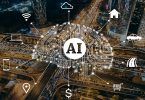When examining what makes automation intelligent, it is important to first differentiate between traditional automation and data-driven intelligence. Automation refers to predefined rules and policies that are programmed to trigger in response to an event. For example, exceeding metrics thresholds would trigger specific control actions. From a ServiceOps perspective, intelligent automation is the ability to automatically kick off a fix that’s been identified through BMC Helix ITSM or BMC Helix Operations Management, or recommend manual fixes that can be executed quickly.
Intelligent automation simulates cognitive thinking for decision making and automation actions. A key differentiator for intelligent automation is that instead of using assumptions or previously known information, it relies on artificial intelligence (AI) models that learn and reason from data, effectively modeling a cognitive thinking engine that makes decisions based on trends and patterns observed in the data.
In this post, we will review some key differentiators between traditional automation and data-driven intelligent automation. First, let’s discuss the key characteristics of AI-based intelligent automation systems:
- Learning and reasoning: The automation technology is capable of learning from past data and using the contextual knowledge to make decisions. This is different from a traditional automation system that only makes decisions based on fixed knowledge pre-programmed beforehand with the given or assumed knowledge of how the system works.
- Adaptability: An AI-based intelligent automation system can account for changes and respond by adapting its reasoning capability in real time based on the availability of new information. System behavior is expected to change rapidly as it scales to a growing user base. These changes are not always predictable and can require thorough analysis, which is a time-consuming effort. AI systems can be tuned to detach from past learnings and embed new knowledge into the models based on real-time data streams. As a result, the model is up-to-date with the data available for training.
- Discovery: IT can only control what they can measure. Considering the complex IT architecture and service delivery models, IT operations and management teams struggle to find relationships and dependencies between application components and IT services. The lack of traceability and discovery of a dynamic service model makes it challenging to assign and find fix rules regarding dependencies. Intelligent automation provides an abstracted view of the relationships by modeling these complex and evolving dependencies with AI, which makes it easier for the system to autonomously trace and discover services.
- Data-driven AI models: The most prominent difference is the ability to learn from data. While traditional automation systems follow predefined rules, AI models simulate system behavior observed in large volumes of log metrics data generated across the IT network. Therefore, the learning of a data-driven AI model is both exhaustive and adaptable. Achieving the same results in a traditional automation system would require exact mapping of all system components and services, as well as true response to all event scenarios, which is virtually impossible to achieve manually considering the vast scale of IT infrastructure operations.
- Real time: AI models can also be trained to learn and respond in real time. Unlike traditional automation systems that trigger an automation action based only on known threshold values, an intelligent automation solution accounts for context, constraints, and patterns that should be evaluated exhaustively to form an intelligent decision. The result is a proactive response action with intelligent automation versus the reactive response of traditional automation tools that require reprogramming or configuration changes to account for real-time changes in system behavior.
- Future predictions: The utility of traditional automation tools is limited to predefined rules: it only triggers a control action when these thresholds are exceeded. AI models allow for intelligent behavior, observing trends and patterns within data and predicting the expected system behavior of a future state. This knowledge cannot be hard-coded but can be trained using information about past events and how they map to potential incidents and service outages.
- Complex modeling: The entire modeling process is a complex endeavor. While it may be virtually impossible to model every state and corresponding system behavior exactly, advanced machine learning (ML) algorithms provide several intelligent mechanisms to learn from data so that explicit modeling of the relationships and dependencies is not required by the AI solution. Instead, it learns to model the system behavior based on a set of inputs (new data at nodes) and outputs (system measurements). The ML model itself can grow to several hundreds of thousands of parameters depending on the model complexity, but that’s far less work than modeling the actual (unknown) state of the system itself.
Combining all these characteristics is a replication of human cognitive behavior. The capability of advanced human-like intelligence augments your existing workforce and can be scaled on demand, instead of employing and training new engineers on traditional automation tools.
Automation and data-driven intelligence are two important concepts that are often used interchangeably, but they are not the same thing. Automation is the process of using technology to perform repetitive tasks, while data-driven intelligence involves using data to make decisions and improve performance.
Incorporating data-driven intelligence can give organizations a competitive edge. If you are interested to see what BMC Helix Operations Management with AIOps can do for your organization, get 14 days free to explore the IT operations toolkit powered by AIOps.







